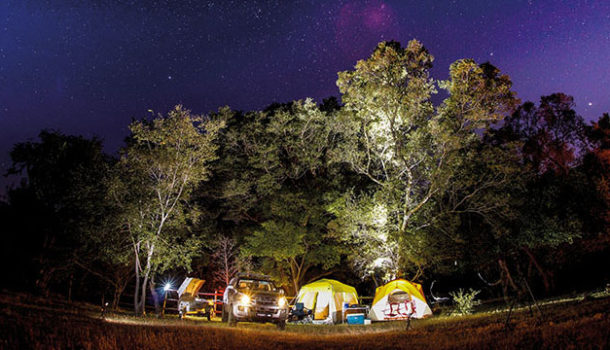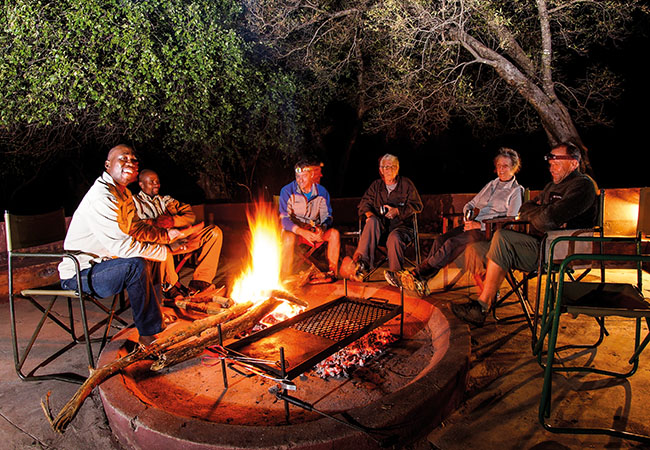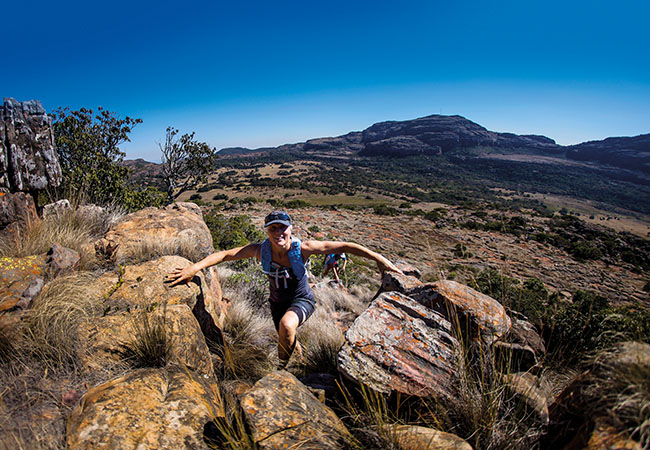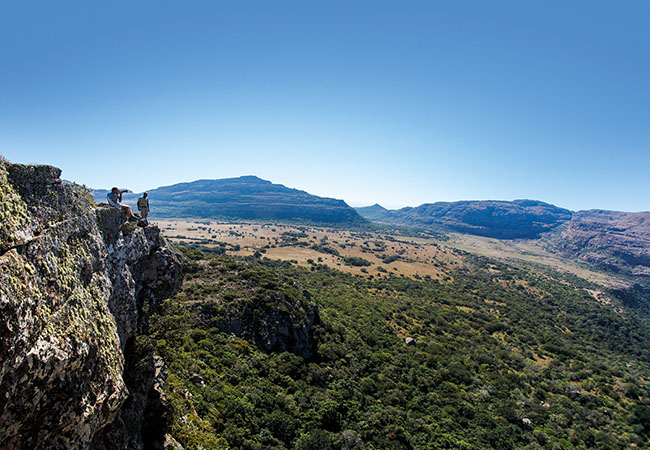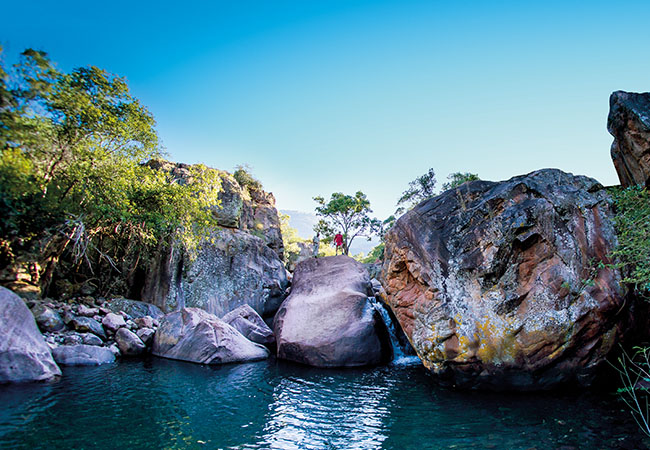While in Limpopo researching his latest guidebook, Jacques Marais happened upon Blouberg, a wonderfully wild spot in the middle of nowhere
Ten days of far-flung family vacationing. Nearly 1 500 km on back-of-beyond roads. And five incredible African Ivory Route camps set within the uncharted heart of Limpopo province at its most wild and remote… Now that is what I call a proper road trip.
All African Ivory Route destinations are guaranteed to get you way off the beaten track, but arguably none more so than Blouberg, somewhere inland from Louis Trichardt. You’ll feel as if you are on a different planet once you find your way there.
Surrounded by the stabbing peaks of the eponymous Blouberg range, the camp itself is set on the densely wooded banks of a cascading mountain stream. Vodka-clear water rushes over polished boulders and, at night, the dark-zone skies are hung heavy with stars, as if you could pluck them from the velvet under-belly of the heavens themselves.
Storytelling around the open firepit will eventually see you off to your tent or bungalow; the soundtrack of the rushing river, punctuated by the eerie hooting of African wood owls shepherding you into dream time.
Sleep may come easily in this natural paradise, but there’s just too much to do at Blouberg to not be ready for the sun when it rises above the rugged landscape. Our guide for the day, Khomotjo Sekiba, already has coffee going on last night’s coals when we get to the boma, just in time for a quick caffeine kicker before heading off on our dawn hike.
The plan is for the whole party from three-year-old Grace to ‘the two old bullets’ (my godparents Delveen and Brian) to walk the 3 km route to Ledjiba la Makgowa (the Pools of the Whites). This constitutes a leisurely two-hour amble with a scenic rest spot amid the big boulders surrounding these crystalline pools.
Afterwards, brunch back at camp fuels us for our next adventure. We’ve checked out the peaks looming all around, and have decided our best bet to see a Cape vulture is get to those craggy summits. This is an intense route with quite a climb, though, so it is only Pete, Karyn and me who slip on our trail-running shoes for a hit-and-run summit attempt.
Khomotjo leads us from the riverine bush into thorny montane vegetation on a rocky footpath zigzagging skywards. ‘There are leopards here, but they mostly keep to themselves in those dense kloofs,’ he explains as we grunt against the tug of gravity. We crest a grassy ridge to pass through an abandoned village and onto the final approach.
We’re not yet home and dry by any stretch of the imagination, as the quick scramble to the summit follows a sketchy line along a near-vertical face bristling with thick and tangled brush. More of a worry is the 1.5m jump we have to make across a gaping chasm, dropping a good 200m down on to the jagged rocks below.
Pumped with adrenalin, we reach the edge of the precipice, where a scalp-tingling view across the wooded plains far beneath us unfolds. We snap a few pictures of the landscape. As we sit trying to catch our breath, a shadow falls across us to block out the afternoon sun.
It’s a colossal Cape vulture, soaring so low we can see its flinty glare as it cocks its primeval head to give us the once-over. The proximity of the bird – one of the key predatory species here at Blouberg – lends the place a prehistoric feel, as if a pterodactyl has decided to grace us with a fly-past, just in case someone potentially tasty has perished during the jump.
Now, I realise this thigh-buster of a hike-scramble-trail-run-climb may not be everyone’s cup of rooibos, but it sure rates as my standout memory of our time at Blouberg. Although it’s only a 12 km return, the cumulative climb is around 1 000m, with much of it a major bundu-bash through thorny thickets and up a ridge littered with loose rock.
Relax… The good news is that this swathe of rural Limpopo land offers way more than just outdoor adrenalin. In fact, the combination of a cultural community angle meshes well with the range of active and leisure options on the outdoor menu at Blouberg.
So, whether you want to soak up the sun, tramp into the emerald undergrowth in search of birds, or go endorphin bedonnerd, you can do it right here.
That night, we huddle close to the warmth of a flickering fire, with croaks, hoots and whistles echoing under the gazillion stars glittering above us. I sense that, once you’ve been to Blouberg, there will always be a small part of your soul that wants to return here, once more.
GOOD TO KNOW
The basics
Blouberg isn’t a resort, and you need to be relatively self-sufficient. You will find yourself surrounded by proper Limpopo veld. Autumn and early winter promise clear skies and cool days (and cold nights, so pack warm clothing). Bring your own sleeping bags and towels.
It’s about as far removed from a catered destination as possible, so shop on your way in, at the town of Indermark. The water is fine to drink. Wood is available at the camp, but at a rather extortionate price.
Hiking routes are unmarked, so you need to be a keen navigator, or make use of one of the local guides.
Getting there
Use a 4×4 or high-clearance SUV or bakkie to reach Blouberg Camp. From Polokwane, continue for 63 km to Dendron and then turn left towards Senwabarwana. Drive for around 20 km before turning right to Indermark, then left again after 1 km to My Darling, and right on to D2233 after 9 km. It should be easy enough to follow the AIR signs from here, with 12.5 km tar and 4 km of gravel to go.
S23 06.626 E28 59.128
Things to do
Once you’ve reached the camp, the best strategy is to forget about your car and hike or bike to wherever you want to be. Saddle up and crank along a rocky 8 km return route to the nearby village if you need a few beers from the shebeen or a plate of sadza.
Hiking routes abound, with the easy 3 km Pools Hike perfect for the family. The Cliffs Hike (12 km return) is cowboy tough; make a call at the abandoned village on the ridge for an 8 km outing. Summitting Blouberg Peak is definitely a full-day affair at 16 km, with a fair bit of scrambling along the way. The cliffs here are also rated as one of SA’s top rock-climbing destinations.
Pre-book a traditional meal in one of the local homes, maybe after shooting pool and sinking a few drinks at the tavern.
Where to stay
The main accommodation is in five thatched self-catering chalets, each of them sleeping two people. Ablutions are en-suite but feature Heath Robinson-style bucket showers.
Camping is a great option, with flat grassy spaces under the giant riverside trees, where you can pitch your tents.
For more information about Blouberg Camp, visit www.africanivoryroute.co.za.
Photography Jacques Marais
(This article was first published in the spring 2015 issue of AA traveller magazine)

